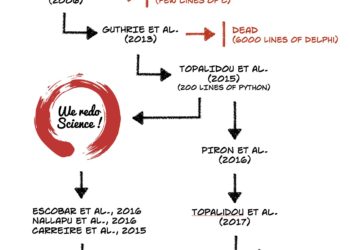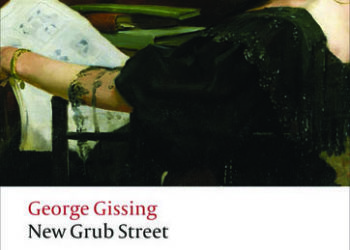As you may have seen, the Contributor Roles Taxonomy (aka CRediT) was recently formalized as an ANSI/NISO standard, making it easier for organizations to give — and individuals to get — recognition for their specific contributions to a research publication (full disclosure: I am Director of Community Engagement for NISO). Getting to this point took a lot of work on the part of many people, not least, the three Co-Chairs of the NISO Contributor Roles Taxonomy Working Group, Liz Allen, Simon Kerridge, and Alison McGonagle-O’Connell. And, while this was a major milestone, there is still much work to be done. So I’m very grateful to Liz, Simon, and Alison for taking the time to tell us a bit about the standardization process, next steps (including launching a new NISO Standing Committee, which will be announced shortly), and opportunities to get involved.
You can read more about the original thinking behind the taxonomy here and if you’ll be at this year’s Society for Scholarly Publishing Annual Meeting, you can also hear more in “Community Standards and Recommendations Supporting Open Scholarship: A Host of Benefits for All“, led by my NISO colleague, Nettie Lagace.

Let’s start with some introductions! Please can you tell us a bit about yourselves, your roles, and how you got involved with CRediT?
Liz: the taxonomy was founded following a workshop co-hosted by Wellcome and Harvard University in 2012 to explore practical ways in which to provide more visibility and provide recognition to the myriad contributions that researchers make to published scholarly output. Following the workshop, a working group of key stakeholders and experts who had been grappling with the same issue, was convened — including journal editors, research funders, institutions and researchers — and CRediT was developed. More on the origins of CRediT can be found here.
Alison: It was 2015 or 2016, and the organization I was working for, Aries Systems, was integrating CRediT role capture as part of the manuscript submission workflow in their flagship product, Editorial Manager. Aries took integrations to the next level in truly partnering with organizations and initiatives within the ecosystem, so it was my role to keep up with CRediT. At the time CASRAI was the ‘parent’ organization for the taxonomy and Simon would convene program committee meetings to keep stakeholders updated and aligned. After a while, he invited me to become a co-chair, which I was, and am, so honored to have been asked to do.
Simon: Yes at that point I was Director of Research Services at the University of Kent and I was on the CASRAI Board — each board member was allocated a particular initiative to drive forward… I jumped at the chance to work on CRediT — it is just such a great idea, and of course I knew Liz already — it is always a joy to work with her!
A number of publishing and other organizations have already implemented the taxonomy, and last year it was awarded the Council of Science Editors Meritorious Achievement Award — why was it important to formally standardize it?
Alison: Over the years, in talking with both tech integrators and publishers, there are always questions about the need for additional roles, or more guidance. These ideas are welcome and fun to explore in discussion, but there has always been a feeling that we are still at the very beginning and needed to first establish a baseline – or the standardized version of the taxonomy hand-in-hand with wider adoption. Only then could we move to the next steps and iterations in an organized and egalitarian way, with feedback considered from a spectrum of stakeholders and an eye toward ecosystem-wide benefit.
Simon: I’m a big advocate of standards, particularly information standards, they underpin so many things, and enable us to do so much more with the associated data. Even if a standard is not perfect — and I am sure that CRediT is not! — wide adoption makes everything easier.
Liz: With any taxonomy, using it in a standard way across systems is crucial to make it useful. Once CRediT had been tested and adopted by a number of publishers within their workflows — and well received overall — we could start working to raise awareness and support further implementation of the taxonomy in its current guise. It was so great to have been recognized for the efforts involved in creating what is in reality a really simple piece of research metadata. Getting the award helps to raise awareness of CRediT and endorses our belief that we have developed something that is useful and welcomed!
One criticism I’ve heard about the current taxonomy is that it is geared primarily at journal publication and at those working in scientific fields. Is that a fair assessment and, if so, are there plans to address this in future?
Alison: Yes, that is a fair assessment of the original scope of the taxonomy. Part of standardizing was to be able to have a foundation from which we could grow and begin to solicit feedback for other use cases including software production, grant applications, preprint or book publications, etc. and also other disciplines such as the humanities.
Simon: Absolutely — another area to look at is to broaden past authorship, for example, could CRediT be used for the acknowledgement section. And to really expand things (and thanks to Lisa DeBruin for the analogy) for team science might we envisage a “movie credits” approach, where all contributions are regularly acknowledged.
Liz: I absolutely agree, and you have to start somewhere! I am a great believer in making practical steps forward, and working with publishers as the first place to start made sense — there is a natural place in the scholarly publishing workflow where CRediT can be captured. As organizations like Crossref and ORCID already enable research article metadata to be captured and shared, we saw a way to ensure that more description about researcher contributions to published work (in addition to being listed as an author) could be simply captured as part of the article submission process. There is of course some extra burden on authors — and publishers — in capturing any extra information when submitting an article, but many publishers have now developed much more automated and simple role capture workflows.
Are there other areas of improvement you’ll be looking at?
Liz: Of course, since we developed CRediT there have been many useful suggestions about how the taxonomy might be evolved or expanded. We are certainly listening and will be working more proactively with NISO to keep the standard relevant, useful, and of practical value! NISO is helping us set up a dedicated CRediT Community Interest Group.
Alison: We will look at all areas of improvement that the Community Interest Group identifies as priorities. It will be open to anyone with an interest in staying informed about future updates to the taxonomy, including providing input and feedback to future iterations.
How will you be taking these ideas forward, and are there opportunities for community involvement in the process?
Alison: We are currently setting up the Contributor Roles Taxonomy Standing Committee, so Simon, Liz, and I will be able to continue our work together with NISO and some other key stakeholders including representatives from a broad range of disciplines and organization types (institutions, publishers, funders, infrastructure/service providers, and more). As mentioned, this work now includes the formation of a Community Interest Group which is limitless, in terms of participation and mission or scope. We want as many participants as possible who want to improve contributor recognition to come to this group, bring their ideas, and work with us. Please sign up here if you’re interested!
Simon: Yes, although it has taken us much longer to get here than we had hoped, we now want to start the group with a renewed vigor!
What advice do you have for any organizations wanting to implement CRediT as a standard?
Alison: Start small. Run a pilot! Evaluate the data, and then go from there. I believe this approach was very successful for organizations such as JBJS.
Simon: Yes, speak to others, learn from their experience.
Liz: I agree with Alison and Simon — speak to other publishers and check out if their workflows and implementation can work for you. Keeping the implementations of CRediT within publisher workflows as standard as possible will help authors get used to how the taxonomy works and reduce any associated burden. Also, speak to NISO! We will be putting more information about how to implement the standard on the CRedit space on the NISO website.
What are some good CRediT implementations that you’ve seen?
Alison: As a marketing professional working for several of the tech organizations that have integrated, I feel a bit biased toward those because I know how much thoughtful work is involved in making a configurable, scalable solution with many different kinds of publishers in mind.
Simon: With my “importance of underlying infrastructure” hat on, for me ORCID’s support of CRediT in their API is a huge step, and the incorporation into institutional repositories another.
Liz: Yes, and the inclusion of CRediT in the Crossref metadata schema is also a massive step forward, and should help to drive further publisher implementation.
Looking ahead five years, what are your hopes for the taxonomy, and what is needed to achieve them?
Alison: I hope that in five years’ time, collecting and sharing – in human and machine readable ways – the specific contributions made by anyone named on a manuscript is commonplace. I hope that the interest and support for evolving CRediT remains strong in the community and that we have momentum to keep going with more iterations of the taxonomy into the future.
Liz: I’d like to see CRediT included in any published research output and that the important contributions to research, in all their shapes and sizes, are visible and recognized as standard in research output metadata. Oh, and through our CIG, I hope we will have developed CRediT 2.0 to keep up with the new types of contributions to research that will no doubt keep emerging as how we do science and research evolves!
Simon: That Alison and Liz get the credit they deserve for running with CRediT all this time! So in five years I hope that they will not need to continue putting all the effort in in the background, as by then CRediT will truly have a life of its own.
Discussion
3 Thoughts on "Next Steps for CRediT – An Interview with the Co-Chairs"
I currently interview UK early career researchers. I have been disappointed in their lack of knowledge of CRediT. They know more about PUBLONS. I think I have pointed out before that like so many such projects few researchers were involved and, for example, I am not aware that ALPSP was asked to take part. I may be wrong. I hope so because I hope it will take off but it will be less of an easy ride if different disciplinary practices are not taken into account
Thanks Anthony. I will leave the CRediT Cochairs to answer more fully about who was involved, but I do know that there was at least one survey of corresponding authors – although that probably wouldn’t include many, if any, ECRs. On the publisher side, the fact that CRediT has already been pretty widely adopted even before it was standardized (see https://credit.niso.org/adopters/) is a good indication that it is being socialized further among researchers. There’s still plenty of work to be done in terms of outreach, for sure, and the taxonomy will also need to be expanded further, especially in terms of non-STEM contributions, as mentioned in the interview. The Community of Interest Group is intended as a way for everyone to be directly involved in sharing their perspectives and needs, so please do encourage the researchers and ECRs you work with to sign up!
Thanks for this and big congratulations on being recognized as a formal standard — an important step. Given the discussion of credit in acknowledgements, credit for other scholarly artifacts, and the general concept of “movie-credit” style attribution, you may be interested in this recent article: “Credit where credit is due” http://dx.doi.org/10.1029/2022eo220239. We address these issues head on. It ain’t easy. So I’m also thrilled that the work is revitalized and continuing. I’ll sign up for the CIG!



